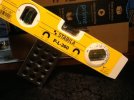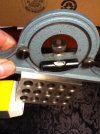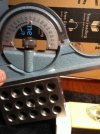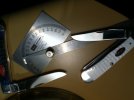You could keep track of the angles and use the sharpie trick to make sure your hitting the bevel. It's the simplest and surefire way to get it done.
Yes that's it ! I just put a few lines of marker marks, I don't color the whole edge, then some super light swipes with the stone in the Edge Pro and within usually two tries I am right on the flat of the sharpening angle and near enough to the actual apex (which has gotten microscopically steeper from use / dulling / hand touch ups with the ceramic rod ) that I can easily apex the edge with a 220 Shapton Glass or similar diamond stone.
This gets us to the angle, what ever it happened to be that worked well with this knife, and no fooling around with angle things.
I just have this old time, inborn "thing" that demands a machined, known flat surface on the angle finder and then a calibrate able protractor bubble configuration. The steel block with the holes in it just allows me to get into a spot that is shorter than the angle measurement tools. Not as convenient as the angle cube or the iPhone.
Call this an irrational obsession.
Alternative to angle cube?
Well you asked.
These are what I would use if I had ever really cared about the actual numbers. I would still have to calculate from there because this (and the angle cube) is only going to give you
an angle relative to the work surface (table). Is the work surface level? Got to check that. Both directions . . . fore and aft . . . port and starboard . . .
why are we doing this again ?
Then take into account the geometry of the grind of the blade.
. . . so anyway . . . if I were to do this I would have probably used these angle measurement tools that I have had forever. I've never even considered using them on my knives until your question here.



The other day I did use the angle tool shown below; after the fact. The edge was sharpened, the Edge Pro was put away and then I was attempting to answer a question about the set up.
This was actually the most direct route and the least expensive. It measures the ACTUAL inclusive angle. Got to look at it with magnification.
By the way this might be a good "check" on how all the cubin' and calculatin' is going for you. Is it . . . in fact . . . accurate to real world measurements ? ? ? ?
(this simple sheet metal tool being the Real World Measurement.)
This tool does take an ever so slight toll on the edge. Most people wouldn't even notice. I couldn't see any edge distortion with magnification.
I resharpened the knife the next day because intellectually I "knew" it was there. In theory the edge had some kind of distortion from this.
Just when I am attempting to sound all rational and stuff.
I better stop while I was almost ahead.









